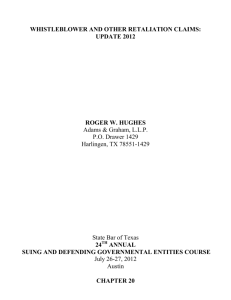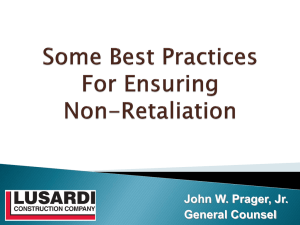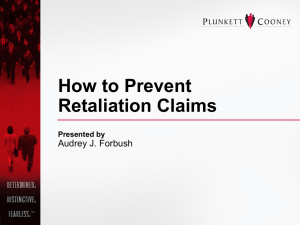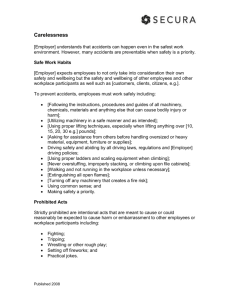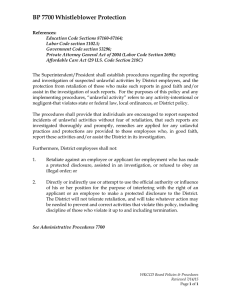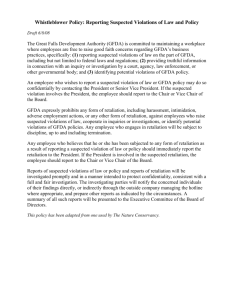2 When a Claim Says “Retaliation,” Think “Insurance Coverage”
advertisement
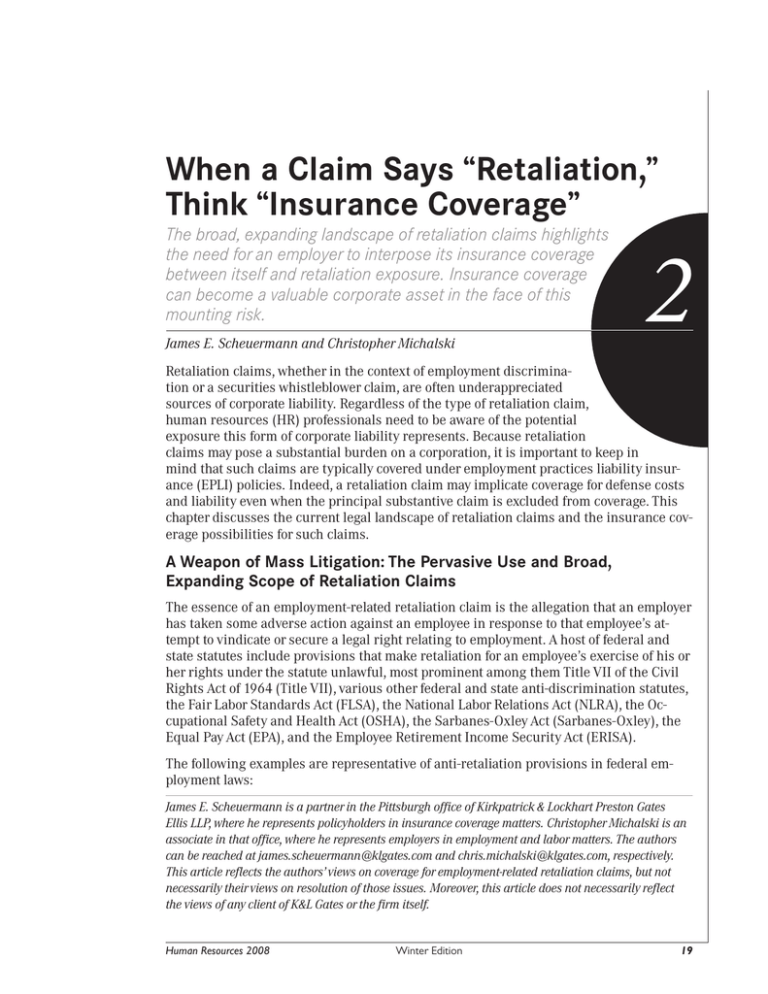
When a Claim Says “Retaliation,” Think “Insurance Coverage” The broad, expanding landscape of retaliation claims highlights the need for an employer to interpose its insurance coverage between itself and retaliation exposure. Insurance coverage can become a valuable corporate asset in the face of this mounting risk. James E. Scheuermann and Christopher Michalski 2 Retaliation claims, whether in the context of employment discrimination or a securities whistleblower claim, are often underappreciated sources of corporate liability. Regardless of the type of retaliation claim, human resources (HR) professionals need to be aware of the potential exposure this form of corporate liability represents. Because retaliation claims may pose a substantial burden on a corporation, it is important to keep in mind that such claims are typically covered under employment practices liability insurance (EPLI) policies. Indeed, a retaliation claim may implicate coverage for defense costs and liability even when the principal substantive claim is excluded from coverage. This chapter discusses the current legal landscape of retaliation claims and the insurance coverage possibilities for such claims. A Weapon of Mass Litigation: The Pervasive Use and Broad, Expanding Scope of Retaliation Claims The essence of an employment-related retaliation claim is the allegation that an employer has taken some adverse action against an employee in response to that employee’s attempt to vindicate or secure a legal right relating to employment. A host of federal and state statutes include provisions that make retaliation for an employee’s exercise of his or her rights under the statute unlawful, most prominent among them Title VII of the Civil Rights Act of 1964 (Title VII), various other federal and state anti-discrimination statutes, the Fair Labor Standards Act (FLSA), the National Labor Relations Act (NLRA), the Occupational Safety and Health Act (OSHA), the Sarbanes-Oxley Act (Sarbanes-Oxley), the Equal Pay Act (EPA), and the Employee Retirement Income Security Act (ERISA). The following examples are representative of anti-retaliation provisions in federal employment laws: James E. Scheuermann is a partner in the Pittsburgh office of Kirkpatrick & Lockhart Preston Gates Ellis LLP, where he represents policyholders in insurance coverage matters. Christopher Michalski is an associate in that office, where he represents employers in employment and labor matters. The authors can be reached at james.scheuermann@klgates.com and chris.michalski@klgates.com, respectively. This article reflects the authors’ views on coverage for employment-related retaliation claims, but not necessarily their views on resolution of those issues. Moreover, this article does not necessarily reflect the views of any client of K&L Gates or the firm itself. Human Resources 2008 Winter Edition 19 Chapter 2: When a Claim Says “Retaliation,” Think “Insurance Coverage” Title VII: It shall be an unlawful employment practice for an employer to discriminate against any of his employees or applicants for employment, for an employment agency, or joint labor-management committee controlling apprenticeship or other training or retraining, including on-the-job training programs, to discriminate against any individual, or for a labor organization to discriminate against any member thereof or applicant for membership, because he has opposed any practice made an unlawful employment practice by this subchapter, or because he has made a charge, testified, assisted, or participated in any manner in an investigation, proceeding, or hearing under this subchapter. FLSA and EPA: It shall be unlawful for any person to discharge or in any other manner discriminate against any employee because such employee has filed any complaint or instituted or caused to be instituted any proceeding under or related to this chapter, or has testified or is about to testify in any such proceeding, or has served or is about to serve on an industry committee. OSHA: No person shall discharge or in any manner discriminate against any employee because such employee has filed any complaint or instituted or caused to be instituted any proceeding under or related to this Act or has testified or is about to testify in any such proceeding or because of the exercise by such employee on behalf of himself or others of any right afforded by this Act. ERISA: It shall be unlawful for any person to discharge, fine, suspend, expel, discipline, or discriminate against a participant or beneficiary for exercising any right to which he is entitled under the provisions of an employee benefit plan, this subchapter, section 1201 of this title, or the Welfare and Pension Plans Disclosure Act, or for the purpose of interfering with the attainment of any right to which such participant may become entitled under the plan, this subchapter, or the Welfare and Pension Plans Disclosure Act. It shall be unlawful for any person to discharge, fine, suspend, expel, or discriminate against any person because he has given information or has testified or is about to testify in any inquiry or proceeding relating to this chapter or the Welfare and Pension Plans Disclosure Act. Third Most Popular Claim The past decade has seen a steady increase in the number of retaliation claims lodged against employers as a percentage of all charges filed with the Equal Employment Opportunity Commission (EEOC). Indeed, as the chart illustrates, retaliation claims accounted for 29.8 percent of all charges the EEOC received in fiscal year 2006, a percentage that is only likely to increase in subsequent years. 20 Year % of Charges Year % of Charges 1997 22.6 2002 27.0 1998 24.0 2003 27.9 1999 25.4 2004 28.6 2000 27.1 2005 29.5 2001 27.5 2006 29.8 Winter Edition ©Thompson Publishing Group Chapter 2: When a Claim Says “Retaliation,” Think “Insurance Coverage” Moreover, according to the reporting statistics, outside of Title VII race and gender charges, retaliation claims are the most prevalent. Indeed, as indicated in EEOC enforcement statistics, www.eeoc.gov/stats/charges.html (as of July 25, 2007), the EEOC received 22,555 charges of retaliation discrimination in fiscal year 2006, which is: • almost nine times the number of religious discrimination claims received (2,541); • nearly double the number of sexual harassment charges filed (12,025); Human Resources 2008 Winter Edition 21 Chapter 2: When a Claim Says “Retaliation,” Think “Insurance Coverage” • more than 40 percent greater than the volume of disability discrimination charges filed (15,575); • more than 36 percent higher than the number of age discrimination claims received (16,548); and • nearly equal the number of gender-based discrimination claims (23,247). While these trends clearly establish that retaliation claims are favored weapons, history is only partially prologue. Recent Supreme Court precedent has set a stage that will likely lead to the filing of more retaliation claims and ensure that such claims continue to be a favored cause of action for employees. The Future – Recent Supreme Court Precedent and New Retaliation Exposure Two recent U.S. Supreme Court decisions may cause retaliation claims to increase in the future. Burlington Northern The Supreme Court in 2006 expanded the scope of employer conduct that can give rise to a viable retaliation claim under Title VII in Burlington Northern & Santa Fe Rwy. Co. v. White (126 S. Ct. 2405). Title VII’s anti-retaliation provision prohibits an employer from “discriminat[ing] against” an employee or job applicant because that individual “opposed any practices” made unlawful by Title VII or “made a charge, testified, assisted, or participated in” a Title VII proceeding, hearing or investigation. Before the Court’s Burlington Northern decision, many federal circuit courts held that a retaliation claim could be maintained under Title VII only if the alleged retaliatory action affected the terms and conditions of employment or constituted an “ultimate employment decision” such as termination, hiring or promotion. Burlington Northern, however, expands the rights of employees under Title VII’s anti-retaliation provision. The expansion stems from the Court’s holding that the anti-retaliation provision applies not just to employment-related actions that adversely affect the terms and conditions of employment (such as firing or demotion), but also to actions not having a direct impact on the employee’s terms or conditions of employment. To support its holding in Burlington Northern, the Court drew an analogy between the anti-retaliation provision of Title VII and that of the NLRA. In determining that retaliation can be found outside the terms and conditions of employment, the Court looked to its rationale in Bill Johnson’s Restaurants, Inc. v. NLRB (1983, 103 S. Ct. 2161). In Bill Johnson’s, the Supreme Court held that “the Court has liberally construed [the NLRA anti-retaliation provisions] as prohibiting a wide variety of employer conduct that is intended to restrain, or that has the likely effect of restraining, employees in the exercise of protected activities.” In articulating its new standard in Burlington Northern, the Court held that a plaintiff alleging retaliation “must show that a reasonable employee would have found the challenged action materially adverse, which in this context means it well might have dissuaded a reasonable worker from making or supporting a charge of discrimination.” The Court emphasized the distinction between “significant” and “trivial” harms when it chose the “materially adverse” language. It noted that Title VII does not prevent an employee complaining of employer discrimination from experiencing “petty slights or minor annoyances that often take place at work and that all employees experience,” since these do not normally deter employees from reporting discrimination or participating in complaints. 22 Winter Edition ©Thompson Publishing Group Chapter 2: When a Claim Says “Retaliation,” Think “Insurance Coverage” Now, following Burlington Northern, normal, facially non-retaliatory conduct may constitute unlawful retaliation because of the context, including factors and conduct outside the workplace. An example of this extension beyond employment that the Court cited is an employer’s filing of false criminal charges against an employee who had filed a discrimination complaint. Further, a counterclaim against an employee in existing litigation may give rise to a claim of retaliation (even though in such a context, the counterclaim may enjoy constitutional protection under the First Amendment). Other examples of what may be considered retaliation, under the broad Burlington Northern standard, include: • a supervisor’s assault on an employee at a local tavern popular with the employer’s work force; • failing to investigate death threats made against a law enforcement agent’s family; or • excluding an employee from social gatherings. In short, this broad and expansive view of retaliation is now etched in the precedent of the two most formidable statutes that affect the daily work life of the HR professional: Title VII and the NLRA. Further, courts may well extend the Burlington Northern rationale to retaliation claims under other statutes, such as the Americans with Disabilities Act, the Age Discrimination in Employment Act, the Equal Pay Act, and the many other federal statutes that use anti-retaliation language similar to that of Title VII. Accordingly, the rationale in Burlington Northern likely will reverberate well beyond Title VII, and expand an employer’s exposure to retaliation claims. Ledbetter In addition to the impact of Burlington Northern, there is a very real possibility that the Supreme Court’s 2007 ruling in Ledbetter v. Goodyear Tire & Rubber Co., Inc. (127 S. Ct. 2162) will lead to the filing of more retaliation claims. Briefly stated, the Court in Ledbetter held that a plaintiff alleging a Title VII violation on the basis of pay discrimination must prove that the discriminatory pay decision occurred during the 180- or 300-day statutory period for Title VII claims. The Court rejected the argument that the effects of an alleged discriminatory pay decision from several years earlier could form the basis for a claim. Accordingly, plaintiffs alleging pay discrimination based on Title VII must file a charge of discrimination within the statutory period of the pay decision. The reasons the Ledbetter decision may yield additional retaliation claims are twofold: 1) Because plaintiffs are required to file charges of discrimination within a short period after a pay decision, more charges of discrimination will likely be filed during the employee’s work tenure (and not post-employment, which may be a more common practice now). Thus, there will be more time in which a plaintiff could be subjected to what is perceived to be adverse treatment and that he or she could argue was retaliation for the allegation of pay discrimination. Thus, in conjunction with Burlington Northern, plaintiffs may have more opportunity to allege acts of retaliation against the employer. 2) When plaintiffs find that Ledbetter has vitiated their cause of action, an additional allegation of retaliation may resurrect an otherwise untimely claim. In other words, a plaintiff may look for more recent employer actions to find a hint of retaliatory conduct to salvage the otherwise time-barred claim. Human Resources 2008 Winter Edition 23 Chapter 2: When a Claim Says “Retaliation,” Think “Insurance Coverage” Sarbanes-Oxley While the above referenced statutes and causes of action may be very familiar to an HR professional, Sarbanes-Oxley provides a relatively new statutory basis for employmentbased retaliation. Section 806 of Sarbanes-Oxley creates a new federal civil private cause of action for employees of public companies who have been retaliated against because of any “lawful act” done to provide information to the government or to assist in a proceeding filed or about to be filed relating to, among other things, fraud against shareholders or violations of Securities and Exchange Commission rules or regulations. Specifically, Section 806 provides that no public company or its officers, employees, contractors, subcontractors and agents “may discharge, demote, suspend, threaten, harass, or in any manner discriminate against an employee in the terms and conditions of employment because of any lawful act done by the employee …” regarding disclosing corporate securities fraud and other related wrongs. Remedies for Section 806 violations include compensatory damages, back pay, attorneys’ fees, and costs. Most discussions of the insurance implications of Sarbanes-Oxley focus on coverage issues under directors & officers policies. The coverage implications of the anti-retaliation provisions of Sarbanes-Oxley under EPLI policies are worth careful attention as well. SarbanesOxley retaliation claims must first proceed in an administrative proceeding and then may be filed anew in federal court. An adequate defense of such claims may involve both employment lawyers and securities lawyers. For these reasons, Sarbanes-Oxley retaliation claims are likely to be costly to defend. Accordingly, the defense coverage available under EPLI policies for a retaliation claim asserted under Sarbanes-Oxley may be of significant value even if the claim proves meritless and indemnification coverage is not forthcoming. EPLI: Exceptions to Exclusions May Implicate Coverage With this outline of the risk that retaliation claims pose, let’s examine how EPLI might cover a retaliation claim even when the EPLI might not cover the principal substantive claim from which the retaliation claim arose. No single, industry-wide standard EPLI policy form exists. Nonetheless, typically EPLI policies cover a host of workplace- and employment-related claims, including: • wrongful discipline; • wrongful termination; • failure to promote; • wrongful demotion; • harassment; • discrimination; • deprivation of a career opportunity; • other violations of employment laws; and • breach of contract. Some EPLI policies expressly cover retaliation while others do not. Depending on the context, any of these other types of covered actions may constitute a form of retaliation, and thus be within the policy’s coverage. 24 Winter Edition ©Thompson Publishing Group Chapter 2: When a Claim Says “Retaliation,” Think “Insurance Coverage” Even if EPLI specifically excludes the principal substantive claim from coverage, it may still cover a related claim of retaliation. Exclusions in many EPLI policies purport to carve out areas of employment-related liability and remove them from the policy coverage. This most frequently happens with alleged violations of: • the FLSA; • the NLRA; • securities laws, including Sarbanes-Oxley; • the OSHA; and • ERISA. Each of these exclusions, however, also commonly includes an exception that preserves coverage for claims of “retaliation” or “retaliatory treatment,” even in those policies that do not expressly mention retaliation in the insurance agreement. For example, the following policy language carves out retaliation claims from the exclusion for the violation of laws (including, e.g., FLSA, OSHA or ERISA) that are applicable to most employers: [This Exclusion] does not apply to any “claim” for retaliatory treatment by an insured against any person making a “claim” pursuant to such person’s rights under any statutes, rules or regulations. More specifically, the following language excludes retaliation from the NLRA exclusion: [T]his Exclusion shall not apply to any Claim for retaliatory treatment of any claimant(s) because of claimant’s actual or alleged exercise of a right protected under the NLRA or related statutes, or any law, statute or regulation similar to the foregoing. Simply put, this means that the EPLI policy would protect the employer against a charge of retaliation for the employee’s exercising rights under the NLRA, even if the court were to find no coverage for the substantive, underlying NLRA violation. The exceptions to the FLSA, securities laws, OSHA and ERISA exclusions typically are similarly worded and the same analysis applies. 10 Questions an HR Professional May Ask When Evaluating Insurance Coverage for a Claim Alleging Retaliation In light of the substantial past and developing future of retaliation claims, policyholders may find it beneficial to review all their employment-related claims and their EPLI policies to determine if retaliation claims have been made for which coverage may be available. Such analysis may suggest a clear path to coverage for those retaliation claims. Moreover, an HR professional faced with an administrative charge or a complaint alleging retaliation usually will be well-served by taking proactive steps in analyzing the claim and seeking the counsel of employment and insurance coverage attorneys, as well as securities attorneys when appropriate. Consider, for example, the following scenario depicting Ms. Green, a seasoned HR professional, and detailing her procedure of choice when navigating the terrain of a retaliation claim. Proactive steps like these may go a long way in helping defend the claim and accessing a valuable corporate asset. On a Friday morning, Ms. Green was greeted with an EEOC charge of discrimination from an employee who had recently complained, through an internal complaint Human Resources 2008 Winter Edition 25 Chapter 2: When a Claim Says “Retaliation,” Think “Insurance Coverage” 10 Questions an HR Professional May Ask When Evaluating Insurance Coverage for a Claim Alleging Retaliation (continued) procedure, about harassment and a problem with her paycheck. The charge detailed the harassment and also explained how the employee’s supervisor found out about the internal complaint. The allegation then detailed how, subsequent to the internal complaint, the employee was: (1) subjected to verbal abuse by her supervisor; (2) excluded from a team building seminar and a summer cookout at the supervisor’s lake house; and (3) passed over for a promotion. Ms. Green knows what to do. First, she contacts her in-house or external employment counsel. Because Ms. Green recently assisted the risk manager in her organization’s renewal of its EPLI policy, she knows that insurance coverage may be available for this charge. Through experience, seminars and training Ms. Green developed her favored procedure on how to help secure her employer’s valuable business asset — insurance coverage — when faced with any charge filed with a federal or state agency or court. Question 1. What does the claim allege? Claims of retaliation will not always be obvious. In reviewing the claim, you may find it useful to determine, with a high degree of specificity, the following: the nature of the claim; whether the employee previously complained about the conduct; the statutes implicated, number of employees involved; and whether the basis for the charge is (1) the individual actions of managers or other employees or (2) the implementation of a policy or procedure. Question 2. Is the retaliation claim a stand-alone claim or a claim added to another allegation of discrimination? This could have an effect on the insurance coverage analysis. For instance, if the underlying claim involves OSHA, the claim may be excluded. If there is also an allegation of retaliation for exercising OSHA rights, however, then coverage may be found in a carve-out to the EPLI policy’s OSHA exclusion. Question 3. Are the claimant’s allegations unique to that individual or could there be similarly situated employees? This may be important for evaluating the claim regarding deductibles, limits, the number of wrongful acts and the potential for an individual claim to turn into a class action. Question 4. Have we taken immediate steps to preserve documents that may be related to the claim, particularly the claimant’s personnel file, and electronic documents that may otherwise be recoverable only with great difficulty and expense? Securing all relevant documents will assist in evaluating the claim and will help determine the nature of the claim, the statute(s) that may be at issue, whether retaliation is present, and whether additional employees could join the litigation or assert additional litigation on their own. Further, such efforts may help avoid the risk of discovery sanctions or claims of spoliation of evidence. Question 5. Have you reviewed all potentially applicable insurance policies, including commercial general liability, directors and officers liability, and EPLI? EPLI often is the most likely source of coverage for most retaliation claims. However, any one of these policies may provide coverage depending on the allegations and facts. Defense costs and liability for a claim could be in the millions of dollars and a few extra hours of thorough policy review may very well be worth the effort. Question 6. Are there questions that require the expertise of insurance coverage counsel and/or the organization’s risk management group? Insurance coverage counsel can assist in evaluating the grants of coverage, the exclusions and the exceptions to the exclusions. Further, insurance coverage counsel can assist the policyholder in complying with procedural requirements that may be a prerequisite to coverage. 26 Winter Edition ©Thompson Publishing Group Chapter 2: When a Claim Says “Retaliation,” Think “Insurance Coverage” 10 Questions an HR Professional May Ask When Evaluating Insurance Coverage for a Claim Alleging Retaliation (continued) Question 7. When was the claim made? There may be an obvious answer, but maybe not. Specifically, did the employee previously complain to a supervisor, to the HR department, through an official complaint resolution program, or through a charge or complaint filed with an agency or in court? The claim’s timing can affect when notice must be given and under which policy a claim should be covered. Question 8. Has notice been given, and, if not, when should notice be given to all potentially implicated insurers? Consult with coverage counsel to determine if notice should be provided and, if so, under which policies and policy periods. Most EPLI policies are “claims made” policies that provide coverage only for claims first made or first reported during the policy period. Question 9. What are the organization’s options regarding the choice of defense counsel? Often, insurers will attempt to impose “panel counsel” on the employer (that is, a law firm appearing on a short list of law firms or attorneys that the insurer has previously negotiated with regarding defense services). However, the use of panel counsel is not always in the insurance contract and, thus, the choice of defense counsel is up to the insured or can be negotiated with the insurer. Remember, it is important that the employer use employment defense counsel in which it has confidence and that understands its business, management and policies. Question 10. Are there any duties or obligations contained in the EPLI policy with which the organization must comply? EPLI policies sometimes include consent clauses and “hammer” clauses, which may create duties and obligations for the policyholder. A consent clause requires the insurer’s consent before the policyholder spends money on defense costs or settlement. One form of a hammer clause provides that if the policyholder refuses to settle an employment-related claim that the insurer wants to settle, then the insurer’s responsibility for any future settlement or judgment may be capped at the amount of the proposed settlement; the policyholder may be responsible for all indemnity owed above the capped amount and for all defense costs from the date of its refusal forward. Accordingly, it is prudent for the policyholder to be aware of the terms of these clauses if included in its EPLI policy before incurring defense costs, settling a claim or rejecting a settlement. Conclusion Retaliation claims are underappreciated forms of corporate liability. While the landscape of retaliation claims broadens and expands, EPLI policyholders can take some comfort in the fact that retaliation claims often are covered — under either a specific grant of coverage or an exception to a coverage exclusion. Insurance coverage is a valuable corporate asset and can protect your organization in these circumstances. Further, while Ms. Green’s suggested 10-step procedure will not cover every aspect of defending a retaliation claim or securing coverage for a claim, it will be helpful to any HR professional as a framework for: 1) organizing the claim, the insurance policies and the relevant documents; 2) assessing the magnitude and potential liability of the case; 3) securing insurance coverage for the retaliation claim; 4) complying with insurance coverage obligations; and 5) maximizing the amount of insurance coverage available to your employer. Human Resources 2008 Winter Edition 27


